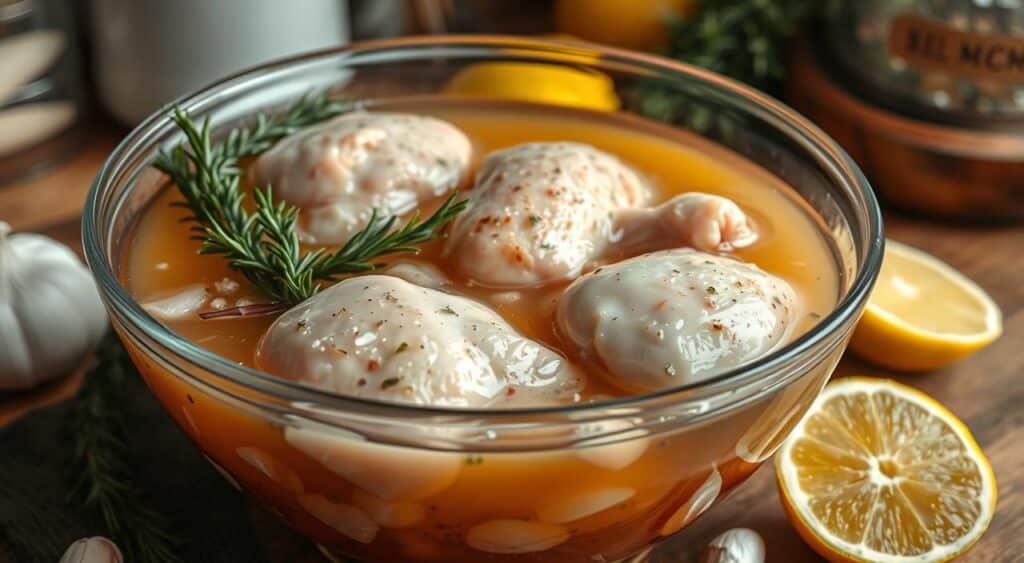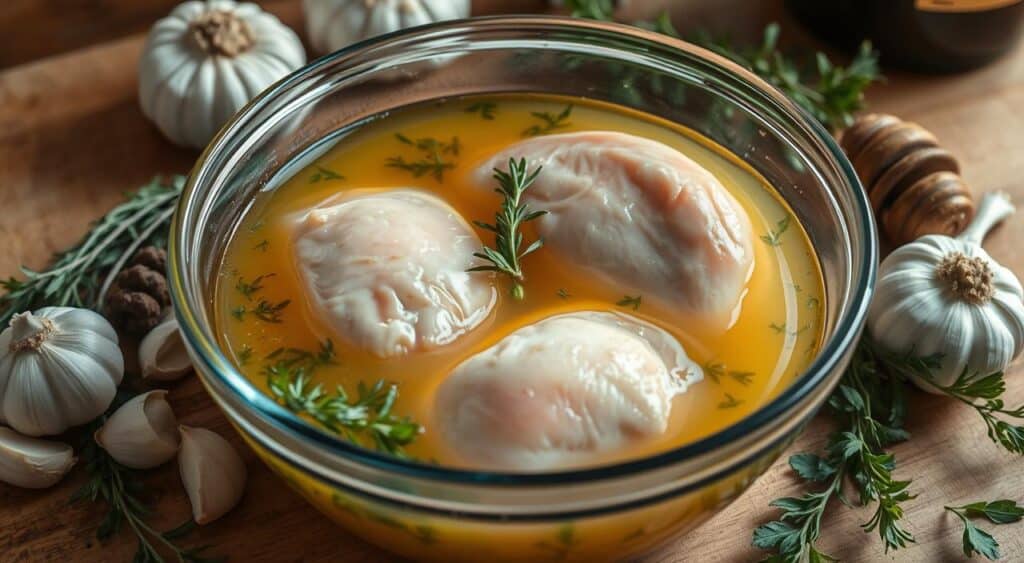Jump to:
Estimated reading time: 12 minutes
Table of contents
How long should I brine chicken? Brining chicken is a game-changer for tender, juicy, and flavorful results. It makes a big difference whether you’re grilling, roasting, or frying. In this guide, we’ll find the best brining time to make your chicken a culinary masterpiece.
How long should I brine chicken? Key Takeaways
- Brining chicken enhances flavor, tenderness, and moisture retention.
- The ideal brining time can vary based on the type and size of chicken cuts.
- Proper brining technique and duration are crucial for avoiding over-salted or under-brined chicken.
- Adjusting brining time based on cooking methods can help achieve the perfect texture and flavor.
- Understanding the nutritional impact of brining can help you make informed decisions about your chicken preparation.
Introduction
Brining is a simple yet effective technique that can transform ordinary chicken into a juicy, tender, and flavorful dish. By submerging the chicken in a salt-water solution, the meat absorbs the seasoning. This results in a more succulent and well-seasoned final product. This introduction will provide an overview of the brining process and its benefits for chicken.
Brining is a popular method for special occasions like Thanksgiving. It can also enhance the flavor and texture of weeknight chicken meals. The process helps the meat retain moisture by breaking down proteins in the chicken.
Wet brines, which involve soaking the chicken in a saltwater solution, take longer but add more moisture. Dry brines, where a seasoning mixture is rubbed directly onto the meat, retain the chicken’s natural juices. This results in more intense flavor and crisper skin.
Regardless of the brining method, the key is to allow sufficient time for the process to work its magic. Dry brines should be left on the chicken for 12 to 24 hours, or up to 3 days. Wet brines require at least 12 hours and up to 2 days for the best results. The choice between wet and dry brining ultimately comes down to personal preference and the desired outcome.
| Brining Method | Recommended Brining Time |
|---|---|
| Dry Brine | 12 to 24 hours, up to 3 days |
| Wet Brine | At least 12 hours, up to 2 days |
Whether you’re brining a whole chicken, chicken thighs, legs, breasts, or wings, the process can enhance the flavor and texture of the meat. This makes it an invaluable technique for home cooks. With the right chicken brine recipe and chicken brine solutions, you can unlock the full potential of your chicken dishes.

“Brining is a game-changer for chicken, transforming it from ordinary to extraordinary.”
Why Brining Chicken is Important for Flavor and Texture
Brining chicken is a key step that boosts the meat’s flavor, juiciness, and tenderness. The salt in the brine breaks down the chicken’s proteins, making it tender. It also adds moisture, making the chicken juicier.
How long should I brine chicken? How Brining Affects Chicken’s Juiciness
Brining chicken keeps its juices in during cooking. By soaking the chicken in a salt-water solution, it absorbs moisture. This makes the chicken juicier and more succulent, especially for lean cuts like breasts.
How long should I brine chicken? Brining for Tenderness and Flavor Infusion
Brining also makes chicken more tender and flavorful. The salt in the brine breaks down muscle fibers, making the chicken tender. This lets the chicken soak up seasonings better, enhancing its taste.
How long should I brine chicken For Optimal results ?
The best brining time for chicken depends on the cut and size. Chicken breasts should be brined for 30 minutes to 1 hour for the best results. Longer brining can make the chicken too salty or spongy, while shorter times may not be as effective.
| Brining Time | Texture and Flavor |
|---|---|
| 30 minutes – 1 hour | Perfectly seasoned, juicy, and tender |
| 2 hours | Overly salty, but still juicy and tender |
| 4 hours | Too salty and significant texture change |
| 8 hours | Too salty and almost spongy in texture |
Knowing the importance of brining and the right brining time can make chicken tender, flavorful, and juicy every time.

Factors That Influence Brining Time
Several factors can change how long you should brine chicken. The size and type of chicken cuts, the salt in the brine, and the brine’s temperature are all important. Knowing these can help you get juicy, tasty chicken.
How long should I brine chicken? Type and Size of Chicken Cuts
The size of your chicken pieces matters a lot. Big pieces like whole chickens or bone-in thighs need more time to soak up the brine. Smaller pieces, like boneless, skinless breasts, soak up flavor faster.
How long should I brine chicken? Salt Concentration in the Brine
The salt in your brine is key. Too little salt won’t work well, and too much can make your chicken too salty. Use about 1 tablespoon of kosher salt for every cup of water. This helps get the right mix of flavor and moisture.
How long should I brine chicken? Temperature of the Brining Solution
The brine’s temperature also plays a part. Colder brines take longer, while warmer ones work faster. Try to keep the brine between 35°F and 40°F for the best results.

“Brining is a game-changer for lean meats like chicken, as it helps to lock in moisture and prevent overcooking.”
How Long to Brine Chicken: A Comprehensive Guide
Brining can make your chicken dishes taste better and stay juicy. It’s important to know how long to brine, whether you’re using a whole bird or just parts. Let’s explore the best brining times for different chicken types.
How long should I brine chicken? Brining Time for Whole Chicken
For a whole chicken, brine it for 6-8 hours. This long soak lets the brine flavor soak into the meat. For the juiciest chicken, aim for up to 24 hours.
How long should I brine chicken? Brining Time for Chicken Breasts and Thighs
Smaller chicken pieces like breasts and thighs need less time. Bone-in parts like chicken thighs should brine for 4 hours. Boneless, skinless pieces can brine for 30-60 minutes. This prevents the meat from getting too salty or tough.
How long should I brine chicken? Quick Brining Techniques for Short Timeframes
If you’re short on time, quick brining methods can still make your chicken tasty. Use a stronger brine solution for faster results, usually in 30-60 minutes. Or try a dry brine by rubbing the chicken with salt and letting it sit for 30-60 minutes before cooking.
“Brining is a chef’s trick that can make a huge difference in the flavor and juiciness of your chicken.”
Success in brining comes from finding the right balance of time and brine strength. Try different methods and adjust the brining time to fit your needs. With practice, you’ll get great results every time.
How to Adjust Brining Time Based on Cooking Methods
Brining chicken’s timing changes with the cooking method. It’s key to adjust brining time to keep chicken juicy, tender, and full of flavor.
Brining for Grilling vs. Roasting
Grilled chicken needs a longer brine, about 8-12 hours. This helps it stay moist under high grill heat. Roasted chicken, however, can brine for 2-6 hours. Its gentle cooking method keeps it tender and flavorful without drying out.
Brining for Frying or Smoking Chicken
Fried chicken benefits from a 2-6 hour brine. This adds flavor and prevents dryness during frying. Smoking chicken, on the other hand, requires an 8-12 hour brine. It absorbs smoky flavors and stays moist during long cooking times.
Brining Times for Sous Vide Cooking
Sous vide chicken needs a longer brine, usually 8-24 hours. This helps it keep its juices and tender texture, important for low-temperature, long cooking.
These times are just guidelines. The best brining time can vary by chicken cut, size, and taste preferences. Try different brining times to find what works best for your cooking method and taste.
| Cooking Method | Recommended Brining Time |
|---|---|
| Grilling | 8-12 hours |
| Roasting | 2-6 hours |
| Frying | 2-6 hours |
| Smoking | 8-12 hours |
| Sous Vide | 8-24 hours |
Common Mistakes When Brining Chicken
Brining can make chicken taste better and stay juicier. But, it’s key to avoid common mistakes. These can ruin your chicken’s taste and texture.
Over-brining: What Happens When You Brine for Too Long
It might seem like longer brining means better chicken. But, over-brining can make chicken too salty and soggy. The brining process helps chicken soak up flavors. But, too long can make it waterlogged and lose its taste.
Under-brining: The Risks of Short Brining Times
Under-brining means chicken won’t get as juicy or flavorful. If brining is too short, chicken won’t soak up enough salt and flavors. This can make it less tender and less tasty.
Not Rinsing Chicken After Brining
Many forget to rinse chicken after brining. Not rinsing can make chicken too salty. The brine left on the chicken will season it more during cooking.
Knowing these common mistakes helps you brine chicken right. This way, your chicken will always be juicy, tender, and full of flavor.
“Brining is an essential step in achieving the best results when cooking chicken. It’s important to follow the recommended guidelines to avoid over-brining or under-brining, and be sure to rinse the chicken thoroughly after the brining process to prevent over-seasoning.”
Alternative Brining Methods to Speed Up the Process
If you need to brine chicken fast, there are quicker methods. Dry brining is a simple way to get juicy and flavorful chicken quickly. It’s faster than traditional wet brining.
Dry Brining: How It Differs and Its Timing
Dry brining, or salt brining, means rubbing chicken with salt instead of soaking it. This method makes the meat tender and juicy. It’s quicker than wet brining, needing only 30 minutes to 2 hours for smaller cuts, or up to 24 hours for a whole bird.
Wet Brining vs. Dry Brining: Timing Comparisons
Dry brining is faster and easier than wet brining. Chicken pieces soak up liquid in 2 hours in a weak brine. Whole chickens can brine for 4 to 24 hours. In contrast, dry brining works in 30 minutes for small cuts and up to 24 hours for a whole bird.
Quick Brine with Salt-Infused Marinades
Using a salt-infused marinade is another quick brining method. Mix chicken with salt, herbs, and other seasonings. The meat absorbs flavors in 30 minutes to 2 hours. This is great for those in a hurry.
Finding the right balance is key in brining. It’s about time, salt, and chicken size for juiciness and flavor. Experiment to find the best quick brining method for you.
Nutritional Impact of Brining Chicken for Different Durations
Brining chicken can change its nutritional value, especially the sodium content. Knowing how brining time affects salt levels is key for those watching their sodium. It helps them enjoy flavorful dishes without overdoing it on salt.
How Salt Levels Affect Chicken’s Nutritional Value
Brining chicken adds salt, which can up the sodium in the meat. The longer it brines, the more salt it takes in. This is something to think about for those on low-sodium diets or watching their salt for health reasons.
Adjusting Salt Intake Through Brining Time
Changing the brining time lets you control the chicken’s saltiness. Short brines, like 2-3 hours, make the chicken less salty. Longer brines, 6-12 hours, make it saltier. This is important for those with dietary limits.
Using Low-Sodium Brine for Healthier Chicken
For healthier chicken, try a low-sodium brine. It lets the chicken soak up less salt but still gets moist and flavorful. This is great for people with high blood pressure or other health issues that need to watch sodium.
Managing the nutritional impact of brining chicken comes down to brining time and salt levels. By understanding these, home cooks can make tasty, healthy chicken dishes that fit their dietary needs.
FAQ: How long should I brine chicken?
Can you brine chicken for too long?
Yes, over-brining can make the chicken too salty and give it a mushy texture. If you need to brine longer, use a weaker brine solution, such as 1/4 cup of salt per quart of water. For most cuts, avoid brining for over 24 hours.
Should I rinse chicken after brining?
Rinsing is optional, but it can help remove excess surface salt. Simply rinse the chicken under cold water and pat it dry with paper towels before cooking. This can be especially helpful for a stronger brine.
Can I add flavors to the brine for chicken?
Yes, you can add ingredients like sugar (for caramelization), herbs (like rosemary, thyme, or sage), garlic, peppercorns, or citrus slices to enhance flavor. These additions infuse subtle flavors into the chicken during brining.
Conclusion: Perfecting Your Chicken with the Right Brining Time
Brining is key to making chicken juicy, tender, and full of flavor. Knowing the best brining times for different chicken cuts and cooking methods helps home cooks get great results. This article has given a detailed guide to help you master brining chicken and elevate your poultry dishes.
Finding the right brining time is crucial for perfect chicken. Whether it’s boneless skinless breasts, bone-in thighs, or wings, the brining time affects the chicken’s texture and taste. By following this guide, you’ll brine your chicken just right, keeping it moist, tender, and full of flavor.
Don’t underestimate the importance of brining time. Brining too little can make chicken taste bland and dry. Brining too much can make it too salty and unpleasant. By perfecting brining, you’ll make chicken that everyone will love. So, next time you grill or bake, make sure to brine your chicken perfectly for a memorable meal.






